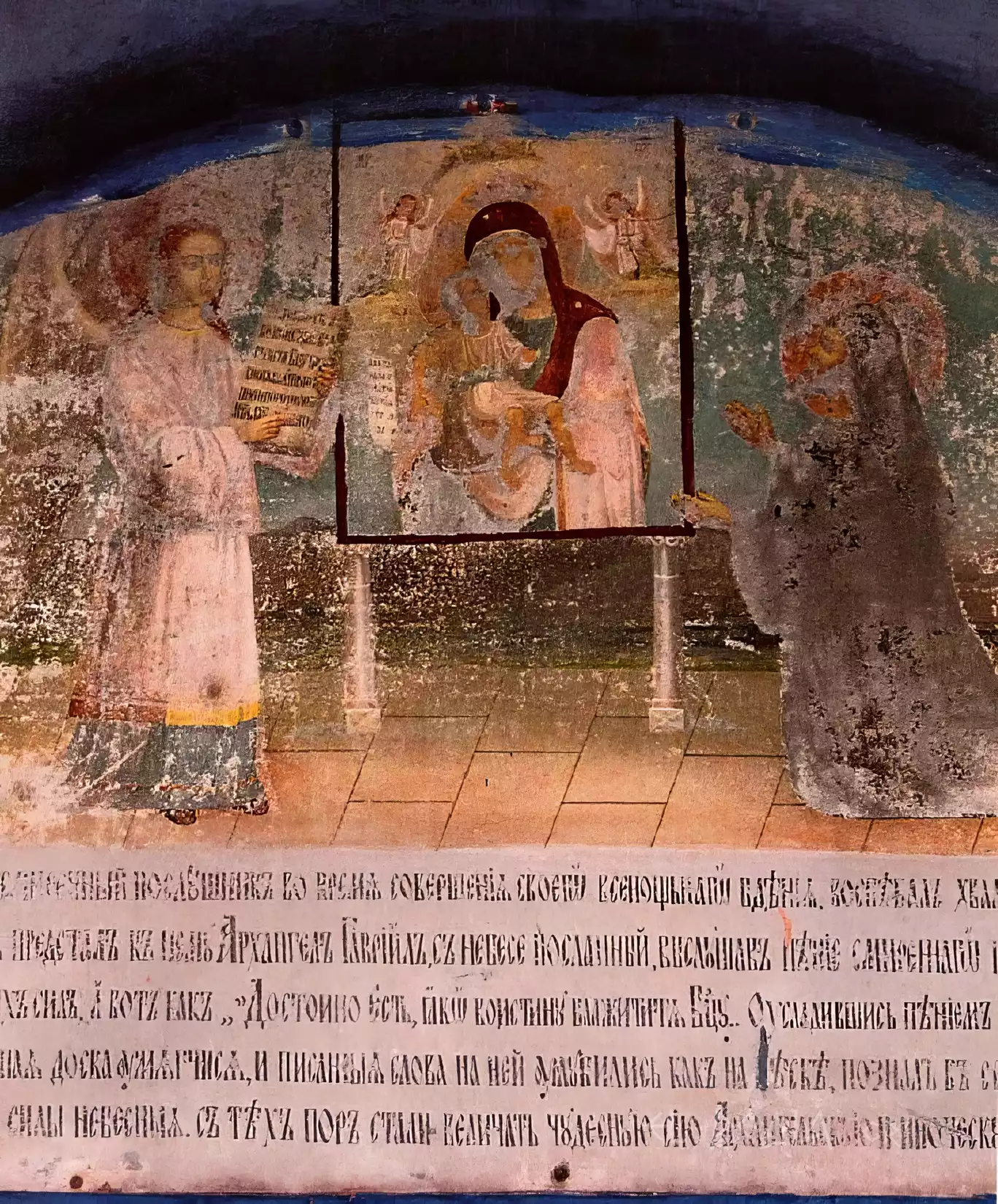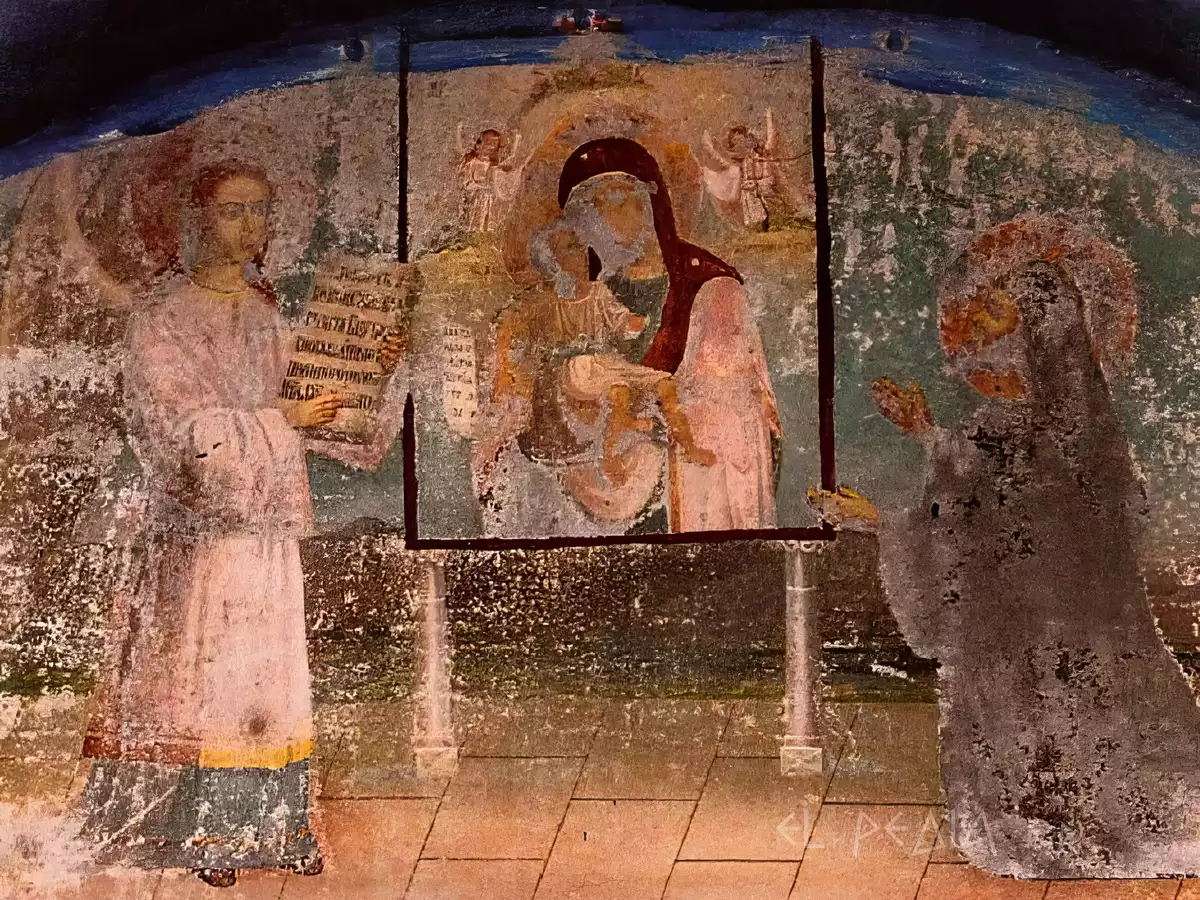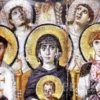
Memory: June 11
Saint Gabriel the Athonite is one of the most significant figures of Athonite monasticism of the 10th century, inextricably linked with the miraculous event of the hymn “Axion Estin” delivery. He practiced asceticism in Karyes of Mount Athos, at the Cell of the Dormition of the Theotokos in the area of Kapsala, which today belongs to the Monastery of Pantokrator. His spiritual journey is characterized by deep humility and dedication to the ascetic life under the guidance of his Elder.
In the year 980 AD, he was deemed worthy of a unique theophany that was destined to change the hymnological tradition of the Orthodox Church. During one night, while his Elder was in vigil at the Protaton church, he received the visit of a monk, who was revealed to be the Archangel Gabriel. The heavenly visitor chanted for the first time the hymn “It is truly meet to bless you, O Theotokos” and inscribed it with his finger on a stone slab.
This miraculous event transformed not only the personal spiritual journey of Saint Gabriel but also the entire liturgical tradition of Mount Athos. His Cell was renamed “Axion Estin” and the icon of the Theotokos, before which the hymn was first chanted, was transferred to the Protaton where it is kept to this day as one of the most precious relics of the Athonite heritage.
Early Life and Monastic Calling
Saint Gabriel, practicing asceticism in Karyes of Mount Athos during the 10th century, was an exemplar of monastic virtue and spiritual cultivation. His settlement at the Cell of the Dormition of the Theotokos in the area of Kapsala marked the beginning of a period of intense spiritual exercise and prayerful deepening. Under the spiritual guidance of a virtuous Elder, Saint Gabriel devoted himself to cultivating monastic virtues with particular emphasis on humility and obedience.
The daily life of Saint Gabriel was characterized by unceasing prayer and fasting, while the reputation of his virtue began to spread within the Athonite community. His ascetic conduct was distinguished by strictness and adherence to the rules of monastic life, elements that became a model for later monks in the area.
His spiritual maturity is reflected in his ability to discern the presence of the divine in daily life, especially during the night services where he often remained alone in his Cell praying, while his Elder participated in the vigils of the Protaton. At that time, the monastic community of Karyes was a center of spiritual radiance, with monks distinguished for their devotion to prayer and the worship of the Theotokos.
The deep spirituality of Saint Gabriel is reflected in his personal relationship with the Virgin Mary, which manifested through the wondrous visit of the Archangel Gabriel to his Cell. This period is characterized by intense liturgical and hymnological activity on Mount Athos, with the development of new forms of expression of worship life and the cultivation of hymnographic tradition.
Historical sources mention that the personality of Saint Gabriel was characterized by a rare combination of spiritual discernment and humility, elements that made him particularly beloved in the Athonite brotherhood. His presence in Karyes contributed to the strengthening of the spiritual life of the area, while his example inspired many later monks to follow the path of ascetic perfection.
The Miracle of Archangel Gabriel
The defining event that marked the life of Saint Gabriel occurred in the year 980, when during a night service in his Cell he received the visit of a mysterious monk. The presence of the visitor, who was later revealed to be the Archangel Gabriel, marked the beginning of a new era in the hymnological tradition of the Church.
That night, while the Elder of Saint Gabriel was at the vigil of the Protaton, the visitor-monk chanted for the first time the hymn “It is truly meet to bless you, O Theotokos”. This divine experience was recorded in a miraculous way, as the archangelic finger inscribed the hymn on a stone slab, thus offering tangible testimony of the divine message.
This was followed by a period of intense spiritual activity in the area of Karyes, with the Cell of Saint Gabriel being renamed “Axion Estin” and the adjacent pit receiving the name “Adein”, imprinting in the geography of the place the memory of the miraculous event. The miraculous icon of the Theotokos, before which the hymn was first chanted, was transferred to the holy sanctuary of the Protaton, where it was placed on the synthronon, behind the holy Altar, becoming since then one of the most precious relics of the Athonite community.
The spread of the hymn to the ends of the world was rapid, as its divinely inspired composition and mysterious origin deeply moved the hearts of the faithful. This event became a reference point for the development of ecclesiastical hymnography and the liturgical tradition of Mount Athos, while at the same time enhancing the spiritual character of Karyes as a center of the Athonite polity.
The testimony of the miracle was preserved through written tradition, with the Protos of Mount Athos, Hieromonk Seraphim the Thypolos, recording the events in detail during the 16th century, thus contributing to the preservation of historical memory and the establishment of the liturgical honor of Saint Gabriel.
Saint Gabriel the Athonite and His Spiritual Legacy
The Athonite tradition preserved with particular care the memory of Saint Gabriel, recognizing his significant contribution to the development of the liturgical life of Mount Athos. The place of his asceticism, the Cell of the Dormition of the Theotokos in Kapsala, evolved into a pilgrimage of particular spiritual significance, inextricably linked with the tradition of “Axion Estin”.
The ecclesiastical memory of the Saint is celebrated on June 11, a day that coincides with the celebration of the miraculous icon of “Axion Estin”. The liturgical Athonite life organically incorporated the divinely inspired hymn into daily prayer practice, making it an integral part of the monastic service.
The literary activity around the person of Saint Gabriel was remarkable, with the hierodeacon Benedict of the Holy Monastery of Saint Panteleimon composing in 1838 the service in his honor, thus enriching the hymnographic corpus of the Church. The artistic depiction of the miracle found its expression in the fresco at the entrance of the Holy Cell “Axion Estin” in Kapsala, which was created in 1897 and depicts the meeting of the Saint with the Archangel.
The timeless impact of the miracle on the spiritual life of Mount Athos is demonstrated by the unceasing performance of worship services at the Protaton before the miraculous icon. At the same time, the theological significance of the hymn “Axion Estin” has been the subject of extensive study and interpretation by patristic writers and theologians, highlighting the multiple dimensions of the Theotokos doctrine.
The presence of Saint Gabriel in the Athonite literature and tradition continues to inspire the monastic community, while his example serves as a model of spiritual discernment and humility. His Cell, maintaining its historical identity, remains a living testimony of the divine visit and a reminder of the continuous presence of the divine in the ascetic polity of Mount Athos.

Iconographic Analysis of the Cell’s Fresco
The fresco composition presents exceptional interest from a stylistic and symbolic perspective. At the center of the depiction dominates the figure of the Theotokos in a rosy background, flanked by two angelic figures. The color palette is dominated by soft tones of pink and blue, creating a sense of transcendence.
The artist, following the traditional Athonite style of the late 19th century, has rendered the figures with delicacy and grace. The folds of the garments are depicted with linear precision, while the faces maintain the modesty and spirituality that characterizes the Orthodox iconographic tradition. The composition is structured in three levels, with the central one being emphasized by architectural elements that refer to the interior of the Cell.
The technical achievement of the artist lies in his ability to convey the sanctity of the moment through the subtle management of light and shadow. Despite the wear of time, the painting surface retains its expressive power. At the bottom of the composition, an inscription in ecclesiastical script is discernible, documenting the historical event.
The Timeless Presence of Saint Gabriel in the Athonite Tradition
The study of the life and spiritual legacy of Saint Gabriel highlights the profound impact he had on shaping the liturgical tradition of Mount Athos. His wondrous meeting with Archangel Gabriel and the delivery of the hymn “Axion Estin” were a turning point for the development of Theotokos hymnology.
The preservation of his memory through iconographic and hymnographic tradition testifies to the significance of the event for the spiritual life of the Orthodox Church. His Cell in Kapsala, renamed “Axion Estin”, remains a living pilgrimage and reference point of the Athonite polity.
The contribution of Saint Gabriel to the enrichment of liturgical life and the timeless impact of the divinely inspired hymn continue to inspire and guide the monastic community, becoming an integral part of the spiritual identity of Mount Athos.
elpedia.gr

